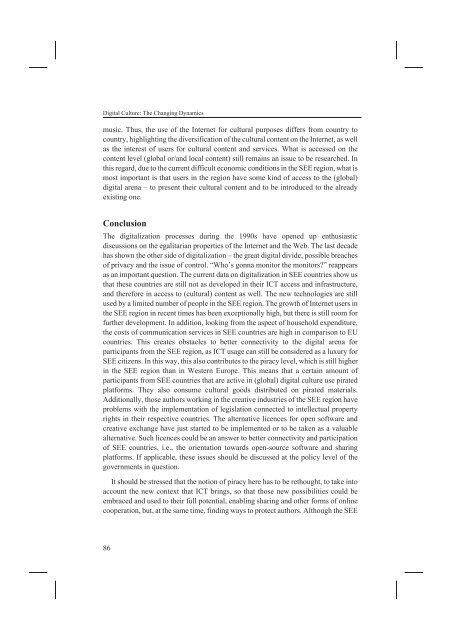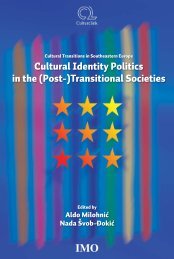D:\Documents and Settings\Ana\My Documents\Biserka-knjiga ...
D:\Documents and Settings\Ana\My Documents\Biserka-knjiga ...
D:\Documents and Settings\Ana\My Documents\Biserka-knjiga ...
You also want an ePaper? Increase the reach of your titles
YUMPU automatically turns print PDFs into web optimized ePapers that Google loves.
Digital Culture: The Changing Dynamics<br />
music. Thus, the use of the Internet for cultural purposes differs from country to<br />
country, highlighting the diversification of the cultural content on the Internet, as well<br />
as the interest of users for cultural content <strong>and</strong> services. What is accessed on the<br />
content level (global or/<strong>and</strong> local content) still remains an issue to be researched. In<br />
this regard, due to the current difficult economic conditions in the SEE region, what is<br />
most important is that users in the region have some kind of access to the (global)<br />
digital arena – to present their cultural content <strong>and</strong> to be introduced to the already<br />
existing one.<br />
Conclusion<br />
The digitalization processes during the 1990s have opened up enthusiastic<br />
discussions on the egalitarian properties of the Internet <strong>and</strong> the Web. The last decade<br />
has shown the other side of digitalization – the great digital divide, possible breaches<br />
of privacy <strong>and</strong> the issue of control. “Who’s gonna monitor the monitors?” reappears<br />
as an important question. The current data on digitalization in SEE countries show us<br />
that these countries are still not as developed in their ICT access <strong>and</strong> infrastructure,<br />
<strong>and</strong> therefore in access to (cultural) content as well. The new technologies are still<br />
used by a limited number of people in the SEE region. The growth of Internet users in<br />
the SEE region in recent times has been exceptionally high, but there is still room for<br />
further development. In addition, looking from the aspect of household expenditure,<br />
the costs of communication services in SEE countries are high in comparison to EU<br />
countries. This creates obstacles to better connectivity to the digital arena for<br />
participants from the SEE region, as ICT usage can still be considered as a luxury for<br />
SEE citizens. In this way, this also contributes to the piracy level, which is still higher<br />
in the SEE region than in Western Europe. This means that a certain amount of<br />
participants from SEE countries that are active in (global) digital culture use pirated<br />
platforms. They also consume cultural goods distributed on pirated materials.<br />
Additionally, those authors working in the creative industries of the SEE region have<br />
problems with the implementation of legislation connected to intellectual property<br />
rights in their respective countries. The alternative licences for open software <strong>and</strong><br />
creative exchange have just started to be implemented or to be taken as a valuable<br />
alternative. Such licences could be an answer to better connectivity <strong>and</strong> participation<br />
of SEE countries, i.e., the orientation towards open-source software <strong>and</strong> sharing<br />
platforms. If applicable, these issues should be discussed at the policy level of the<br />
governments in question.<br />
It should be stressed that the notion of piracy here has to be rethought, to take into<br />
account the new context that ICT brings, so that those new possibilities could be<br />
embraced <strong>and</strong> used to their full potential, enabling sharing <strong>and</strong> other forms of online<br />
cooperation, but, at the same time, finding ways to protect authors. Although the SEE<br />
86



